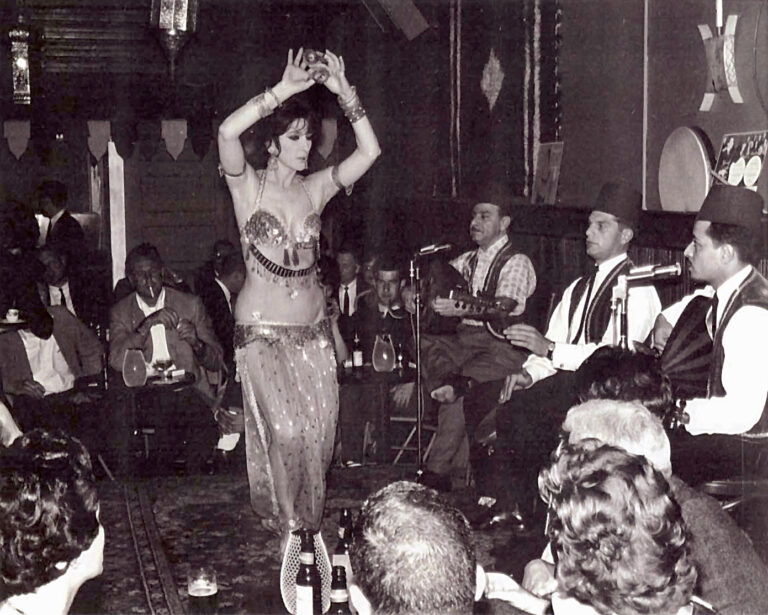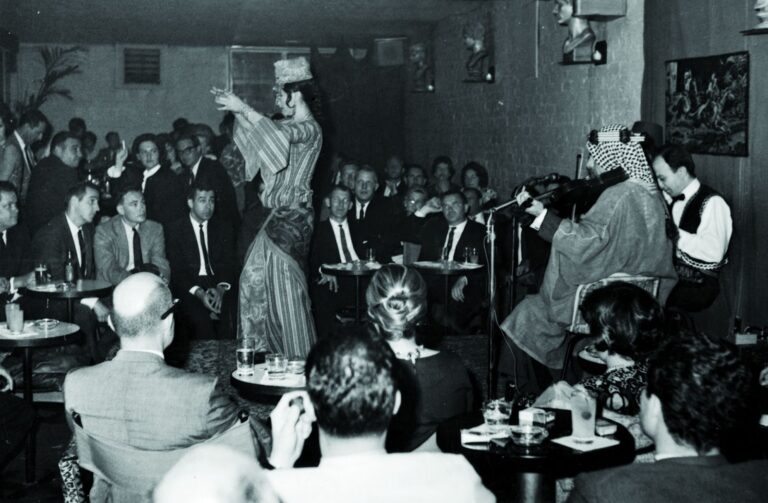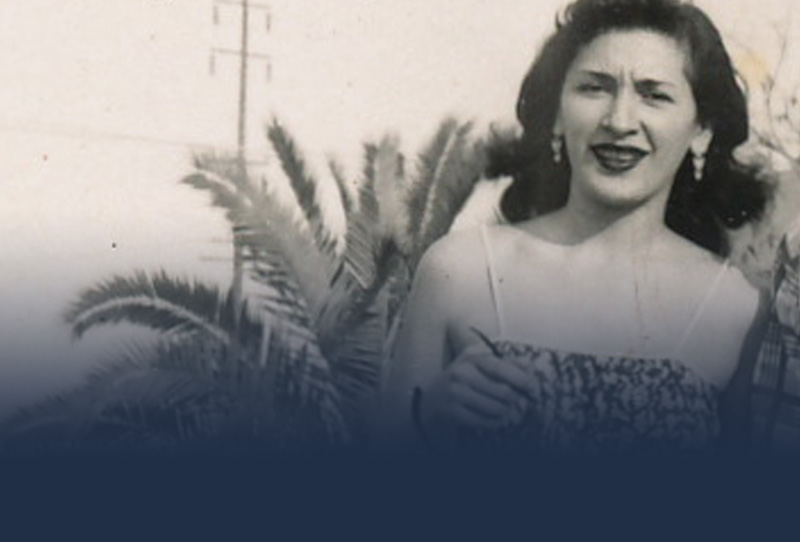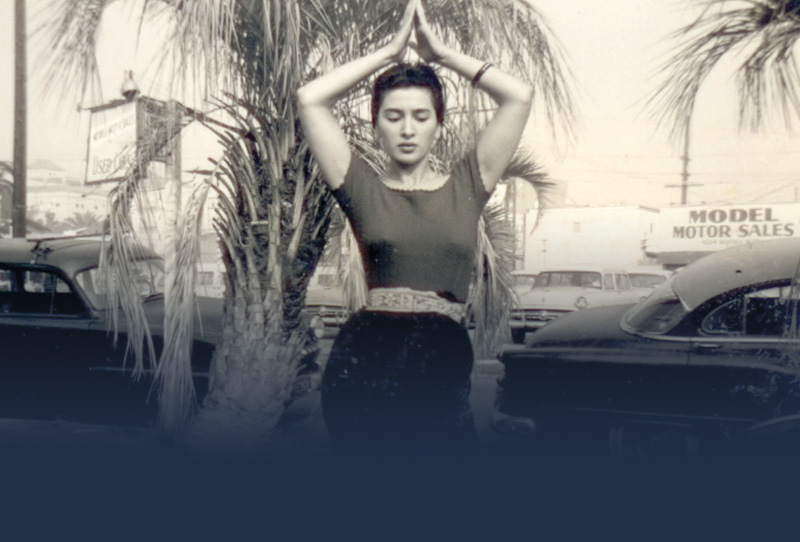Habibi: Vol. 8, Nos. 7&8 (1984)
Early Influences
I first became enamored of oriental dance through my father, who saw dancers on the streets of Egypt in 1910. He wrote:
The first time I saw an Arabian dancer it was at Alexandria, Egypt, in 1910, on a corner of a public square on a canvas-like carpet. There were three players: a clarinet (mizmar), a chitar (could have been a bouzouk), and a drum (darbouka). The dancer was barefoot, bare arms to the shoulder, bare back down to the curve of the buttocks—there a belt holding a tight-fitting indument ending in strips of different colors halfway down the legs. She had a large necklace made out of small discs of white metal, probably tin—a row white and one yellow—probably gold gilded—kept together with thin chains of the same color. These discs were about the size of a dime on top—distant one another one diameter—a larger size of discs down next row and so on, seven inches or eight inches long—two small cups for brassiere that would come up from a garment held up from the belt in front leaving uncovered the front of the stomach—rings on both arms and forearms to the wrist, three or four up and six or so below to the wrist. The twistings were to the music and the onlookers would throw money on the canvas. The party would scramble, and she would quickly get covered otherwise she would get pinched for it was performed on a public square. The English were there at the time, and we all would feast our eyes for we liked to look at that type of dancing. When I was in Tunis or Algeria or Oran or Tripoli or Bengazi more or less it was the same…

Dialects of Dance
I didn’t edit my father’s writing because I didn’t want to lose the flavor of his language and descriptions. What he saw in Egypt was probably a Ghawazee and, as limited as her dance might have been, it was risqué compared to the Victorian dances of that time. It might have been an Ouled Nail that he saw dancing in the tourist towns of Algeria. Whatever he saw, we now know that they aren’t all “the same”. The countries are different, the languages are different, and the music and dances are different. Let me tell you some of my experiences while trying to specialize in Egyptian dance.
My father loved Egyptian dance, and it pleased him when I became a professional. In my early years, I emulated his imitation of Egyptian dancers, and later I gleaned whatever I could from monthly visits to the Egyptian movies. I consider Tahia Carioca my first real teacher, although, sitting through the early musicals for all three shows was hardly the disciplined training one would have needed for a good foundation in Egyptian dance. I chuckle when I think that Mahmoud Reda might have been watching and studying his Fred Astaire movies at the same time I was watching Tahia Carioca. All of Egypt was watching Fred and Ginger. Whatever the culture, genius is truth and truth is universal, whether it is music or dance or whatever!

After the Egyptian movies, I would practice almost as soon as I got home, trying to remember the steps and details. I didn’t know how to take notes, and I was at a disadvantage not being able to study the film whenever I wanted. It sure would have been great to rerun those dance passages!
In her earlier movies, Tahia Carioca played opposite Farid al-Atrash and danced to tunes, some of which I still hear today being played for new dancers. Tunes like “Yah Binty Beledi”, “Zaina”, “Ana Winta”, and “Tuta” are just a few of the many songs and dance musicals that stirred the hearts of listeners. Many of the songs were composed by Farid al-Atrash. Tahia Carioca became more popular as an actress, and, as she got older, she danced less and less in her movies. In some of her dramatic films, other lesser-known dancers would be hired to dance. Many times we were in for a pleasant surprise, especially in the wedding scenes—the perfect excuse to feature a dancer. I was sometimes overwhelmed at the folk talent who wouldn’t even be listed in the credits. Like unbelievable fireflies, they appeared and glowed and suddenly were gone! Who were they? Where did they come from? Did I really see what I think I saw? I would try to remember some of the moves so that I could include them in my repertoire.
The Dance Evolves
Since all of my exposure and training was Egyptian, my early approach to the dance lent itself mainly to Egyptian music. It was frustrating to be hired to dance in a club that didn’t have any Egyptian musicians, only to be expected to follow whatever the musicians managed to play. In many cases, each musician came from a different country in the Middle East. To most of them, music was a hobby. They had never been professional musicians back home. Since Middle Eastern musicians were scarce in the United States, most club owners were desperate to have anyone play, even though many of them were limited in their knowledge of music. In many cases it was literally every man for himself.
When I began going on the road, it didn’t take very long before changes took place in my name and my dance. Originally, I was given the name Gamila by an Egyptian. When I was hired to dance as a regular in a club in Fresno, they announced me with a J instead of a G, making my name a Turkish pronunciation instead of the original Egyptian. Also, most of the played music was Turkish; they were songs I had never heard or danced to before. My dance style was Egyptian, but a job was a job, so I tried to adjust. For me it wasn’t easy. Egyptian music was slower, more lyrical, and the dance smooth and flowing. These musicians chose fast music, and I frantically tried to keep up. It was like, “off to the races!” It seemed to me that the same thing happened in most of the Greek clubs in which I worked. The favorite song, imported from the club Zara in Boston, was “Soude Soude”. I heard it night in and night out for my performances, punctuated periodically by “Doctor Jivanum” and “Kadifeden Kesei”.
In the mid-50s, I was offered a job I couldn’t refuse in San Francisco at the now landmark club, 12 Adler Place. The orchestra was comprised of a Turkish qanun player, Iraqi violinist, Palestinian oudist, and a newly acquired Persian drummer. All except the Persian drummer sounded Middle Eastern. He had played zarb (Persian drum) in Iran but was very slow to adapt to Middle Eastern music. Since there was no other drummer available, they had to make do with him. He couldn’t get the hang of baladi or taqsim or masmoudi—you name it! And he wasn’t interested either! He was in this country to go to school. Then, a dynamic Arab drummer, Ronnie Kirby, came to town and worked in a rival club across the street. He was such an incredible drummer that they featured him in every set. He would put his chair in the center of the stage and hypnotize everyone! What a talent! Now the Persian was inspired to develop. All the better for us! I wanted a drum solo, and up until then, he couldn’t play it for anyone. He did his homework, and, in time, became rather well-known.

But still no Egyptian musicals. The orchestras played “medleys”: a bit of this and a bit of that. One musical they all learned to play between dancers was “Aziza”. They played it exactly as Muhammad Abdel Wahab wrote it; I know they could have played other compositions, but they were not interested. There were no such things as rehearsals. The musicians worked at their “real” jobs during the day. The qanun player and the drummer went to school, the oudist sold insurance, and the violinist laid rugs. Only a few times a dancer came to work who demanded a rehearsal. She had to be strong to get it, and when she did, the musicians would begrudgingly show up in the afternoon and “put up” with her requests for a particular musical and insistence on certain lights and drum cues. It’s what every dancer should have gotten but, if you were a regular, the games started. If you complained about the music or the games, you got subtly threatened with the hiring of another dancer. So, for weeks and months and years, you pretty much got the same music night after night. There was little growth. Perhaps we all became more slick and polished, but the music and dance were becoming more removed from their origins. More than one club owner remarked that since American customers didn’t know or understand the music, they might get bored, and so his remedy for a successful show was to speed it up! Eventually, every entrance was fast, and we were all expected to “keep up” or retire. If we made any waves, the musicians would not play well for us, and it would seem like our dance was “slipping.” It was a feat to do a 45-minute dance when the entrance was so fast. What a relief when the taqsim came! Some time to relax!
Americans seemed to expect certain things of the dance. Zagat (finger cymbals) seemed to symbolize the dance; instead of using them to accent the music appropriately, we were encouraged to play them continuously. In an Egyptian environment, we did not do any floor work and barely any veil work. As the dances became longer and longer, we all looked for dancing patterns to “pace” ourselves and “take up” more time. And so, veil work became longer and floor work became routine, patterned, and extensive. The Egyptian dance was becoming more removed from its origin. Originally, the clubs that had catered to foreign audiences played more musicals and featured vocalists rather than dancers. Since American tourists outnumbered guests from the local communities and didn’t understand the vocalists’ lyrics, the dancers became the feature and again the format changed. When I complained about the extended length of my dances, one club owner told me that the new audiences were there to see women dancing. Since customers were not interested in the music, it was good for business to see a dancer on stage moving at all times.
As the dance format became elongated, a routine evolved which was to become known as the three-part or sometimes five-part routine. Musicians and dancers became locked into this pattern by habit and convenience, and this format became standard. To accommodate American dancers, records put out by the local club musicians began appearing with the three- or five-part format that had developed in the United States. There was a demand by the growing number of Middle Eastern dance enthusiasts who were flocking to teachers like myself who had worked in the clubs.
An interesting phenomenon had taken place from the time I seriously began working in clubs until I started teaching. I had to do a lot of thinking to reason out the whys and wherefores. When I first came up to San Francisco in the mid-1950s to work at 12 Adler Place, the first and then only Middle Eastern club in San Francisco, someone had tacked a newspaper clipping to the dressing room door which told how the immigration department of the American government was not allowing any more oriental dancers to work in the United States. I had heard stories of con games which had led to several deportations. One evening as I was getting ready to go to the club, there was a loud knock on our hotel door; two Immigration detectives demanded we open the door and answer questions. I was sharing a room with another dancer, and we had nothing to hide. I opened the door to two burly officers who were serious and very businesslike. “Are you Jamila? Are you a citizen? Where were you born? What street? What was the address?” The questions came fast and furious! I could see that if I or anyone else couldn’t answer quickly and with confidence, we would be escorted to jail and deported soon after. It was a frightening experience and quite common in those days. The club owners were becoming frantic! There was no new influx of dancers. Those of us who were working were now at a premium!
But what happened to the dance? When I married in 1965 and began teaching, I taught my club routine which by then was an American adaptation of Egyptian dance. After several years I began bringing Egyptian dancers to San Francisco to present them in workshops. It became most apparent that an artistic gap had developed. All the things that had happened in Egypt—Mahmoud Reda, the National Folkloric Troupe of Egypt, and the influence through their lead dancers who later became the choreographers for top dancers of Egypt—all these things were only rumors and distant to us at that time. Also, Nadia Gamal had left Egypt and now could only be seen in the clubs in Beirut, Lebanon. She was the forerunner of the tightly choreographed dance which I think influenced many of her colleagues whom she left in Egypt. Working closely with musicians and composers, Ms. Gamal paved the way for the development of an extended dance vocabulary.
But still no Egyptian musicals. The orchestras played “medleys”: a bit of this and a bit of that. One musical they all learned to play between dancers was “Aziza”. They played it exactly as Muhammad Abdel Wahab wrote it; I know they could have played other compositions, but they were not interested. There were no such things as rehearsals. The musicians worked at their “real” jobs during the day. The qanun player and the drummer went to school, the oudist sold insurance, and the violinist laid rugs. Only a few times a dancer came to work who demanded a rehearsal. She had to be strong to get it, and when she did, the musicians would begrudgingly show up in the afternoon and “put up” with her requests for a particular musical and insistence on certain lights and drum cues. It’s what every dancer should have gotten but, if you were a regular, the games started. If you complained about the music or the games, you got subtly threatened with the hiring of another dancer. So, for weeks and months and years, you pretty much got the same music night after night. There was little growth. Perhaps we all became more slick and polished, but the music and dance were becoming more removed from their origins. More than one club owner remarked that since American customers didn’t know or understand the music, they might get bored, and so his remedy for a successful show was to speed it up! Eventually, every entrance was fast, and we were all expected to “keep up” or retire. If we made any waves, the musicians would not play well for us, and it would seem like our dance was “slipping.” It was a feat to do a 45-minute dance when the entrance was so fast. What a relief when the taqsim came! Some time to relax!
Americans seemed to expect certain things of the dance. Zagat (finger cymbals) seemed to symbolize the dance; instead of using them to accent the music appropriately, we were encouraged to play them continuously. In an Egyptian environment, we did not do any floor work and barely any veil work. As the dances became longer and longer, we all looked for dancing patterns to “pace” ourselves and “take up” more time. And so, veil work became longer and floor work became routine, patterned, and extensive. The Egyptian dance was becoming more removed from its origin. Originally, the clubs that had catered to foreign audiences played more musicals and featured vocalists rather than dancers. Since American tourists outnumbered guests from the local communities and didn’t understand the vocalists’ lyrics, the dancers became the feature and again the format changed. When I complained about the extended length of my dances, one club owner told me that the new audiences were there to see women dancing. Since customers were not interested in the music, it was good for business to see a dancer on stage moving at all times.
This article was published in Jamila’s Article Book: Selections of Jamila Salimpour’s Articles Published in Habibi Magazine, 1974-1988, published by Suhaila International in 2013. This Article Book excerpt is an edited version of what originally appeared in Habibi: Vol. 8, Nos. 7&8 (1984).
Photo Credits
- Postcard photograph of two Egyptian Ghawazi dancers., circa 1900, Léon & Lévy, Public domain, via Wikimedia Commons, https://commons.wikimedia.org/wiki/File:167_Egyptian_types_and_scenes_-_Arab_Dancing_Girls.jpg
- Young Cabaret Dancer, Photograph, Jules Gervais-Courtellemont, Young Belly Dancer, 1926. Autochrome Lumière, Washington, DC, National Geographic Society, no. 940009, CC BY-NC-ND 4.0, https://brill.com/display/book/9789004449886/BP000013.xml?language=en
- Jamila dancing in a nightclub.
- Jamila dancing in a nightclub.
- Jamila dancing in a nightclub.


